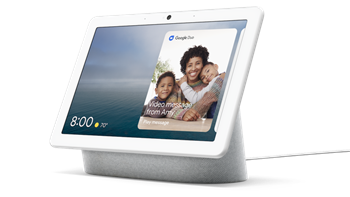Google used its I/O developer conference in Mountain View, Calif. Tuesday to introduce a new smart display device: Nest Hub Max, as the device is being called, features a 10-inch screen, a better-sounding speaker, and an integrated camera for video chatting that doubles as a Nest security camera and also offers gesture control. Nest Hub Max is set to ship this summer, and will cost $229.
Nest Hub Max is also the first Google device to use the company’s Nest branding for its in-home smart speaker hardware, extending a brand best known for smart thermostats to entertainment and communications devices. “It’s true, Google and Nest are finally coming together,” said Google Nest product manager Ashton Udall during a recent interview with Variety.
The introduction of the Nest Hub Max goes along with a rebranding of the Google Home Hub, which is now being called the Nest Hub. The two devices are very much siblings, offering much of the same functionality: Both come with integrated far-field microphones for a smart speaker-like experience that can be activate with the “Hey Google” wake phrase. Both feature video-optimized routines, and both can be used to control other smart home devices with a simple dashboard.
The key difference between the Nest Hub Max and its smaller sibling, aside from the display size, is the integrated camera. When Google first introduced the Home Hub last year, the company made a point of omitting that camera, pitching it as a more privacy-focused device that you could put on your bedside table without having to worry about the mere possibility of someone watching you.
The flip side of that design choice meant that you couldn’t use the Home Hub for video chatting, which is where the Hub Max comes in. The device has Google Duo video calling built-in, making it possible to launch video calls to most modern Android phones as well as iPhones who have the Duo app installed.
You may not want to put the Hub Max in your bedroom, acknowledged Udall, but he argued that many consumers may be comfortable enough with cameras elsewhere. “Hub Max is designed to be in the shared living spaces of your home,” he said. “Hub Max can be a great kitchen entertainment device.”
To optimize the Hub Max for family video chatting, Google gave it a camera with a 127 degree field-of-view. The company also added some computer vision smarts that make it possible to follow someone around and keep them in the center of the video — an experience that is similar to the way Facebook’s Portal video chat device works, albeit without a zoom. Said Udall: “Everybody can get in the frame.”
Another interesting feature: The Hub Max supports gesture control, with limited functionality at launch. Users can lift up their hand for a stop gesture to pause media playback at any time, something that Udall billed as an easier way to interact with the device whenever there is a lot going on in your kitchen. The company didn’t announce any plans for additional gestures Tuesday, but one could easily imagine the Hub Max getting swipe controls to switch back and forth in recipes without having to touch the screen with your dough-kneading fingers. “It’s definitely on the table,” Udall said about additional gestures.
The addition of a camera also makes it possible for the Hub Max to recognize people entering the room, and personalize calendars, contacts and other content for them. This is essentially an extension to the voice match technology that is already integrated into the Home Hub, and all of the facial recognition is being done on-device. “We can make sure everyone gets their own personal information,” said Udall.
In addition to all of those features, the Hub Max camera can also be used as a security camera to monitor your home when you are away. Given the branding, it’s not a big surprise that it takes some cues from the Nest Cam, offering free live monitoring, with an option for up to 30 day continuous recording in the cloud for an additional monthly subscription fee. However, unlike the Nest Cam, the Hub Max doesn’t support night vision.
Anyone not feeling comfortable with having that camera run 24/7 can disable it with a hardware switch that also physically disconnects the build-in microphones. Asked why the company didn’t opt for a camera shutter that would have allowed to keep the microphone active, Udall said: “We wanted to give people a very strong solution that is simple.” There is a way to disable the camera in the software setting of the Hub Max, but that may not satisfy more privacy-conscious consumers.
Google is nonetheless putting a bigger emphasis on privacy, which includes the publication of a new set of privacy principles, and changes to its Nest developer policies.
And while the Nest Hub Max does double as a security camera, the company is clearly not looking to replace security-focused products like its own Nest Cam with it. “We are selling it as a smart display first,” said Google vice president Rishi Chandra.
In many ways, the introduction of the Nest hub Max also means that Google is doubling down on smart displays. Said Chandra: “That category is going to be the centerpiece of the helpful home.”
Source: Read Full Article
